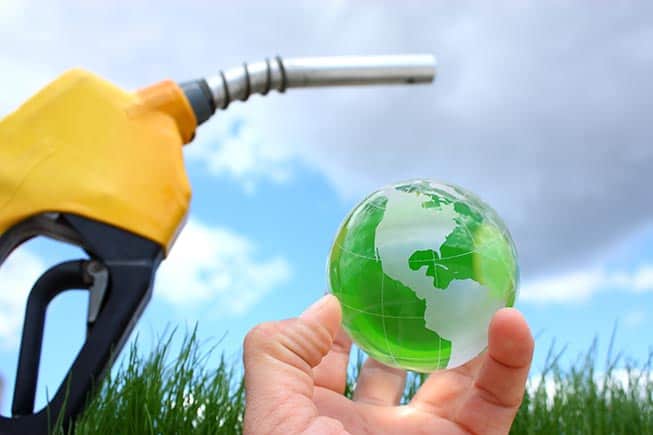With the rising cost of fuel seemingly never coming to an end, any way to reduce costs is a benefit to the average RV owner. Biodiesel is an alternative that can not only lessen your reliance on petroleum products, but is an eco-friendly option to spewing nasty emissions into the environment. But, can RVs run on biodiesel?
RVs can run on biodiesel, however, there are a few considerations to take into account. “Biodiesel” is not clearly defined, so the mixture can vary. Additionally, you can’t just roll up to your nearest gas station and be assured that there is a pump that contains just biodiesel. Regardless of such limitations, with a bit of knowledge and elbow grease, an RV can start running on more environmentally-friendly biodiesel.
What Is Biodiesel?
Biodiesel is a mixture of diesel fuel and plant oils. Usually, these oils are mostly made up of soybean oil but the typical biodiesel blend contains no more than 20% bioproducts and over 80% diesel.
With this mixture, your diesel engine won’t need a conversion of any kind to run on biodiesel. RVs can just fill up and drive, as if you had just fuelled up with standard diesel, no conversion kit necessary!
The exception is for those eco-types who wish to do the full conversion and head to the road with a tank full of just vegetable oil; This will require a conversion kit.
Understanding Your RV’s Diesel Engine
When diesel engines were first invented back in the 1800s, they were designed for the fuel sources that were readily available at the time. This included coal dust, kerosene, and peanut oil. Interestingly, diesel engines are still much the same as they were when they were chugging along fuelled by vegetable oil and grease.
Due to the unchanged design of these engines, RVers- technically- can start pumping up with biodiesel this afternoon before heading out on the next adventure.
However, if an RV was manufactured before 1994, a little work is required to make
the engine run smoothly. Replacing all rubber hoses and fuel lines can make the system compatible with biofuel.
The engine won’t require any kind of mechanical alterations whatsoever. But, that doesn’t mean you just switch out hoses and lines and you’re done. Running a vegetable oil mixture as your primary fuel source for your RV is going to require you to spend a bit more time under the hood than you may be accustomed to doing.
Here’s why: your RV has been using petroleum diesel for a long time. As a result, there are going to be a lot of deposits inside both the engine and the fuel tanks. The first few months you start using biodiesel with be the most critical as the lubrication coming from the vegetable oils are going to work those deposits free, and send them directly to your fuel filter. This means you are going to experience frequent changes in fuel filters until the deposits are gone.
Cold Weather Will Make a Difference
Weather’s affect on biodiesel is an important factor to consider. Cold, frigid climates will essentially turn biodiesel into a buttery, molasses-type consistency, somewhat similar to head cheese.
This will become challenging at times and will require more changes of fuel filters than when you first started using biodiesel.
But there are ways around this. Your first option is to used what is known as a B5 biodiesel blend: The ratio of biodiesel to standard diesel is reduced to about 5% plant oil to 95% diesel. For some RVers, that may just reduce the whole desire to run biofuel in the wintertime which brings us to option Number Two: You could just revert to operating your rig on straight-up diesel until spring. It’s your call.
Where to Get Biodiesel

We’ve already hinted that you won’t see a biodiesel tank neatly tucked next to your regular diesel tank at every gas station in the nation.
For RVers who prefer hitting the back roads to see the country that the average tourist avoids, you will be hard-pressed to find biodiesel at the “last gas station for 100 miles” you encounter. This may make it tempting to either cook up your own recipe or visit that guy in the next town who makes his biodiesel with BBQ grease and other unknown ingredients. That doesn’t mean these are not good ideas. They just might not be the best ideas.
Large-scale, commercial production facilities are your best bet for quality biodiesel simply because they will have strict guidelines to follow in the manufacturing process. The downside, as mentioned, is you will have to do some homework to locate the suppliers along your route if you are stubborn about using only biodiesel when you travel.
How Much Does Biodiesel Cost?
Here’s the reality check regarding going green on your RV fuel. Following the 9/11 terrorist attack, biodiesel was a bargain as all other petroleum-based fuels jumped in price but that is no longer the case.
Oil prices eventually dropped and although there is a little up and down action at the pumps, generally speaking, diesel prices today are actually less than biodiesel if you can find it.
For eco-friendly RVers, it’s a tough sell to pay twice the price of diesel fuel to reduce emissions and have a cleaner engine. Will that change? Very likely, but that’s a whole different article on a slightly different topic. The upside is that as the use of biodiesel increases, so does the demand and for countries seeking alternatives to fossil fuels, plant oil-based fuels will slowly gain a better foothold on the market. But it is going to take time.
What About Grease Fuel?
As explained, biodiesel is a blend of very little vegetable oil to standard diesel. It is very different from grease fuel which is made from just vegetable oil.
There are two very distinct variations of grease fuel: SVO (straight vegetable oil), and WVO (waste vegetable oil). But don’t get it in your head that you can hit up your nearest fast food restaurant and buy up drums of their kitchen grease and pour it directly into your fuel tank once the RV is packed for the road. The engine will require a few mechanical modifications that you will not be able to Macgyver your way through.
This means hiring a mechanic… and probably one with an hourly rate in the $200+ range. Oh, and if you thought finding biodiesel at Exxon was difficult, grease fuel is even scarcer than that. [Disclaimer: grease fuel is not recognized by federal governments/agencies as a renewable, green, or alternative fuel!] So, although your RV is going to smell like dinner wherever you take it, you may want to pass on this fuel source for now.
Final Thoughts
RVing is a great way to travel, but it isn’t the cheapest way to get where you’ve got to go.
Fortunately, diesel engines can operate on alternative fuel – biodiesel. It will clean your engine and the fuel system, but require you to keep up on fuel filter changes for the first little while.
And provided you can find biodiesel in your travels, it won’t be fun in the colder months.
Additionally, if saving money at the pumps is the goal, biodiesel isn’t going to be all that helpful as it’s an expensive alternative. Hopefully, as biodiesel is adopted by more drivers in the future, the cost will decrease.
Now, if you’re looking at running a cleaner rig, and the increased price of fuel doesn’t scare you off, then biodiesel might be just the right type of fuel for you and your RV.


